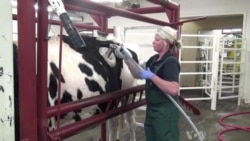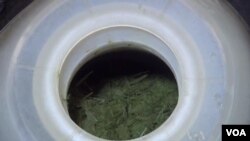BOULDER, COLORADO —
Medical doctors fight many infections with antibiotics, but a procedure that makes many people cringe can be more effective in curing serious infections.
The process involves rebalancing a sick intestine with fecal microbes from a healthy donor.
Donor animals
In the United States, this unusual treatment was first inspired by animal doctors.
At Colorado State University in Fort Collins, veterinarians use donor animals to cure digestive disorders in other animals, not with a kidney donation or a blood transfusion, but with healthy gut microbes. One donor is a black-and-white cow named Hershey.
“We probably bring her in twice a week to provide rumen fluid for treating our patients," said Rob Callan, who harvests microbes from Hershey’s stomach on a regular basis. "She’s been here eight years. That’s got to be close to at least 800 patients.”
He gathers the microbes directly from her stomach through a small plastic porthole in her side.
“We often get asked whether or not it hurts," said Callan. "After it’s in and it’s healed, they don’t feel it any differently than normal skin.”
As Hershey calmly watches, Callan opens the porthole to reveal what’s left of her latest meal - a mass of warm, wet, stinky grass. He says its potent odor comes from microbes digesting the grass. These microbes can counteract the toxins of harmful gut microbes, so to gather a “donation,” Callan and his team insert a tube through the porthole and siphon out the greenish liquid.
Animal doctor Jenifer Gold says it can then be transfused into another cow through a tube down its throat.
“You’re taking the tube and going down into the stomach, and from the stomach it will get passed down to the GI tract," Gold said.
There are also beneficial microbes at the other end of the GI - or gastro intestinal - tract.
“If you have a horse that has very bad diarrhea, you actually get a healthy horse’s feces," Gold said. "You turn it into a mush so you can pump it through.”
Fecal transplants for humans
For generations, veterinarians have used stool from healthy animals to treat a variety of intestinal disorders in livestock. Half a century ago, their success inspired a Denver doctor to try the procedure to help people.
“That was 1958. That’s when the first published experience with fecal transplants was done,” said Steve Freeman, a gastroenterologist at the University of Colorado Medical School.
Dr. Ben Eisman “transplanted” normal human feces into four men who had a deadly intestinal infection in the 1950s. “All four survived and left the hospital actually fairly quickly. Even though they’d been in the intensive care unit and not too far from dying just days earlier. So it was pretty dramatic.”
However, the procedure did not catch on, probably because of what Freeman calls the “yuck” factor.
"The yuck factor has always been a very big drawback to this therapy,” he said.
Overcoming the 'yuck' factor
Two years ago, Freeman overcame the yuck factor to cure a digestive disorder that infects hundreds of thousands in the United States and is increasing worldwide. It kills 14,000 Americans every year. The infection is C. diff colitis.
Charmayne Cesal lives in Wyoming, where her doctors tried to kill off her C. diff with a powerful antibiotic called Vancomycin. Cesal says whenever her prescription ended, her C. diff roared back.
Thinking a fecal transplant might be more effective, her doctors referred her to Freeman. He consulted the handful of doctors in the U.S. who use stool transplants to introduce healthy microbes into their patients’ intestinal tracks.
Some infuse liquefied stool into the stomach through a nose tube. Others use enemas, or a colonoscopy, a medical procedure where a tube is inserted into the colon. Freeman opted for a colonoscopy for Cesal and then went looking for an appropriate donor.
“They’re screened with cultures of their stool to look for C. diff and other enteric pathogens and parasites," Freeman said. "They’re screened with blood tests to be checked for infectious diseases such as hepatitis, HIV, and syphilis.”
Fecal transplant patient
Cesal’s donor was her husband and she became Denver’s first modern-day fecal transplant patient.
“I’ve not had any problems since," Cesal said. "Such a simple thing to get rid of something so horrible.”
Freeman has now done more than two dozen fecal transplants. He says studies from Europe match his own observations that they work better than antibiotics.
“The transplants tend to be successful anywhere from 85 percent to 90 percent of the time," he said. "Whereas once a person has relapsed on Vancomycin two times or more, the likelihood tends to be less than 50 percent.”
Yet fecal transplant is such an unusual procedure that earlier this year the U.S. Food and Drug Administration (FDA) instituted stringent restrictions on doctors who wanted to do them. With the growing number of successful procedures, the FDA relaxed its requirements in July, though they urge more studies of the therapy.
The process involves rebalancing a sick intestine with fecal microbes from a healthy donor.
Donor animals
In the United States, this unusual treatment was first inspired by animal doctors.
At Colorado State University in Fort Collins, veterinarians use donor animals to cure digestive disorders in other animals, not with a kidney donation or a blood transfusion, but with healthy gut microbes. One donor is a black-and-white cow named Hershey.
“We probably bring her in twice a week to provide rumen fluid for treating our patients," said Rob Callan, who harvests microbes from Hershey’s stomach on a regular basis. "She’s been here eight years. That’s got to be close to at least 800 patients.”
He gathers the microbes directly from her stomach through a small plastic porthole in her side.
“We often get asked whether or not it hurts," said Callan. "After it’s in and it’s healed, they don’t feel it any differently than normal skin.”
As Hershey calmly watches, Callan opens the porthole to reveal what’s left of her latest meal - a mass of warm, wet, stinky grass. He says its potent odor comes from microbes digesting the grass. These microbes can counteract the toxins of harmful gut microbes, so to gather a “donation,” Callan and his team insert a tube through the porthole and siphon out the greenish liquid.
Animal doctor Jenifer Gold says it can then be transfused into another cow through a tube down its throat.
“You’re taking the tube and going down into the stomach, and from the stomach it will get passed down to the GI tract," Gold said.
There are also beneficial microbes at the other end of the GI - or gastro intestinal - tract.
“If you have a horse that has very bad diarrhea, you actually get a healthy horse’s feces," Gold said. "You turn it into a mush so you can pump it through.”
Fecal transplants for humans
For generations, veterinarians have used stool from healthy animals to treat a variety of intestinal disorders in livestock. Half a century ago, their success inspired a Denver doctor to try the procedure to help people.
“That was 1958. That’s when the first published experience with fecal transplants was done,” said Steve Freeman, a gastroenterologist at the University of Colorado Medical School.
Dr. Ben Eisman “transplanted” normal human feces into four men who had a deadly intestinal infection in the 1950s. “All four survived and left the hospital actually fairly quickly. Even though they’d been in the intensive care unit and not too far from dying just days earlier. So it was pretty dramatic.”
However, the procedure did not catch on, probably because of what Freeman calls the “yuck” factor.
"The yuck factor has always been a very big drawback to this therapy,” he said.
Overcoming the 'yuck' factor
Two years ago, Freeman overcame the yuck factor to cure a digestive disorder that infects hundreds of thousands in the United States and is increasing worldwide. It kills 14,000 Americans every year. The infection is C. diff colitis.
Charmayne Cesal lives in Wyoming, where her doctors tried to kill off her C. diff with a powerful antibiotic called Vancomycin. Cesal says whenever her prescription ended, her C. diff roared back.
Thinking a fecal transplant might be more effective, her doctors referred her to Freeman. He consulted the handful of doctors in the U.S. who use stool transplants to introduce healthy microbes into their patients’ intestinal tracks.
Some infuse liquefied stool into the stomach through a nose tube. Others use enemas, or a colonoscopy, a medical procedure where a tube is inserted into the colon. Freeman opted for a colonoscopy for Cesal and then went looking for an appropriate donor.
“They’re screened with cultures of their stool to look for C. diff and other enteric pathogens and parasites," Freeman said. "They’re screened with blood tests to be checked for infectious diseases such as hepatitis, HIV, and syphilis.”
Fecal transplant patient
Cesal’s donor was her husband and she became Denver’s first modern-day fecal transplant patient.
“I’ve not had any problems since," Cesal said. "Such a simple thing to get rid of something so horrible.”
Freeman has now done more than two dozen fecal transplants. He says studies from Europe match his own observations that they work better than antibiotics.
“The transplants tend to be successful anywhere from 85 percent to 90 percent of the time," he said. "Whereas once a person has relapsed on Vancomycin two times or more, the likelihood tends to be less than 50 percent.”
Yet fecal transplant is such an unusual procedure that earlier this year the U.S. Food and Drug Administration (FDA) instituted stringent restrictions on doctors who wanted to do them. With the growing number of successful procedures, the FDA relaxed its requirements in July, though they urge more studies of the therapy.












